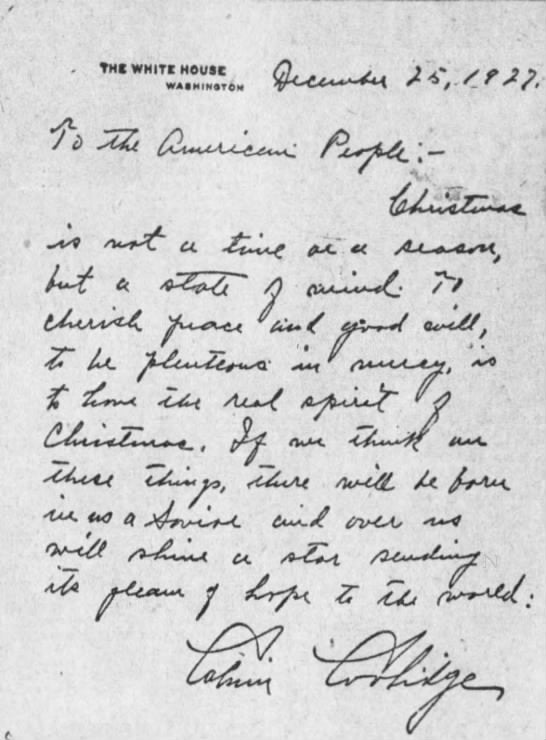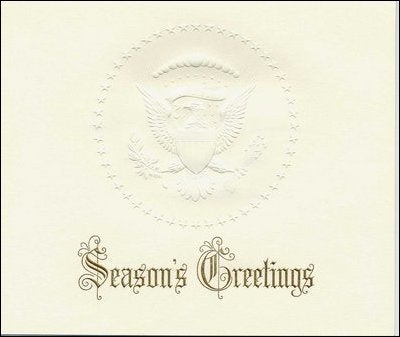Six of the most iconic White House Christmas cards
The White House holiday card tradition has survived World Wars, assassinations, and the removal of the word ‘Christmas’
It has become tradition for the president of the United States to send out a holiday greeting card in December, and this year will likely be no different.
The first presidential holiday greetings were sent out as personal Christmas cards from leaders to their friends, family and colleagues. They were not sent in any official capacity; they were just something the presidents at that time wanted to do.
Since then, the tradition has become an official function of the president.
Although the number of people who end up on the recipients list for the Christmas cards has grown significantly in recent years, it is still considered a rare honour to be included on the mailing list if you are not a lawmaker, diplomat or government official.
For the rest of us who didn't make the cut, here is a list of six of the more interesting White House Christmas and holiday cards.
Calvin Coolidge, 1927

Though historians do not provide a conclusive date for the start of White House Christmas traditions, Calvin Coolidge is often credited with beginning two of the most iconic presidential Christmas traditions; issuing a holiday greeting, and lighting the White House Christmas tree.
Some historians say Mr Coolidge was sending out Christmas greetings in the early 1920s, but the first official greeting associated with him was sent in 1927.
The 1927 message was written in the president’s hand on a stark piece of White House stationary. The message was dated 25 December, 1927, and was directed “to the American People".
"Christmas is not a time or season, but a state of mind. To cherish peace and goodwill, to be plenteous in mercy, is to have the real spirit of Christmas – If we think these things there will be born in us a Savior and over us all will shine a star – sending is gleam of hope to the world," the message said.
Mr Coolidge lit the White House Christmas tree in 1923, during a ceremony called the Pageant of Peace.
According to the White House Historical Association, Mr Coolidge also sent Christmas greetings to a six-man Arctic expedition team, who were likely some of the closest humans to the north pole at that time.
Franklin Delano Roosevelt, 1944

No president has sent more Christmas greetings than President Franklin Delano Roosevelt. That is largely by default, as he was in office for 12 years.
Mr Roosevelt's Christmases spanned an exceptionally tumultuous time in American history – his term began amidst the Great Depression, and ended just after World War II.
The 1944 White House Christmas card was issued in the midst of World War II, and featured Mr Roosevelt and First Lady Eleanor Roosevelt seated beside a lit fireplace.
"With Christmas greetings and our best wishes for a Happier Nineteen Forty-five. The President and Mrs Roosevelt," the card read.
The image likely reminded recipients of Mr Roosevelt's fireside chat radio broadcasts, which became a source of comfort and a reminder of stability for Americans during the most violent and brutal years of the war.
During his 12 years in office, Mr Roosevelt spent 10 Christmases in the White House, and two at his home in Hyde Park, New York.
Every year on Christmas Eve, Mr Roosevelt hosted a party for the White House staff, where he and Ms Roosevelt would try to greet all of their staff and give them small gifts to thank them for their work.
Dwight D. Eisenhower, 1953

Up until President Dwight D. Eisenhower, the Christmas greetings sent out by presidents were largely personal greetings. According to the White House Historical Association, the first official presidential Christmas card was sent by Mr Eisenhower in 1953.
The card, produced by Hallmark, was striking for the image that dominated its cover sheet – the Presidential Seal. The card was embossed on the front with holly leaves and berries, and inside bore the signatures of Mamie Eisenhower and the president.
Hallmark produced 1100 cards, which were sent to diplomats, cabinet members, Congressional lawmakers and other government officials.
The Eisenhowers also commissioned 500 personal cards that they sent to friends and family members.
Mr Eisnhower included the Presidential Seal on every card he sent during his time in office.
The text inside the 1953 card was simple: "Merry Christmas and Happy New Year", followed by the signatures of the president and the first lady.
Mr Eisenhower was an artist, and used his talent to produce Christmas gifts for White House staff members. In 1953, the president painted a portrait of Abraham Lincoln while he was waiting for news on the Korean armistice. He reproduced the portrait and gave copies to his staff at the White House Christmas party that year.
Lyndon B Johnson, 1963

Presidential Christmas greetings can be used not just to send goodwill to the public, but also to address the national mood.
In 1963 President Lyndon Johnson sent out a subdued, minimal Christmas card.
The card featured a stark white Presidential Seal and came in two variants: one that said "Blessed Christmas" and another that said "Seasons Greetings".
The bottom of the card included a red border.
The card used the simple design because it was issued during the official mourning period following the assassination of President John F Kennedy.
The card replaced the Kennedy’s official card, which included a photo of the nativity scene in the White House East Room. The cards were signed but were never sent, and remain the most rare White House Christmas cards in existence.
Five days after Mr Kennedy's death, the White House's chief of protocol advised Mr Johnson to keep up the tradition of issuing a Christmas greeting, despite the dire circumstances.
That year's recipients list was far more limited than it had been in past years, and included few government officials and lawmakers.
On 22 December, 1963, Mr Johnson led a candlelight memorial service for Mr Kennedy, noting the Christmas holiday in his address.
“So let us here on this Christmas night determine that John Kennedy did not live or die in vain, that this nation under God shall have a new birth of freedom, and that we may achieve in our time and for all time the ancient vision of peace on earth, good will toward all men,” he said.
George W Bush, 2002

By 2002, the official White House Christmas cards had stopped using the word "Christmas", replacing the proper noun with the more inclusive "seasons greetings" or "happy holidays". Even so, the tradition of sending out a greeting card during the winter holidays persisted.
That year, President George W Bush and First Lady Laura Bush chose an image of a 1938 Steinway grand piano inside the White House Grand Foyer for their card that year, which was painted in photo-realistic style by artist Zhen-Huan Lu.
Outside of the impressive work of art, the card is otherwise unremarkable when viewed against other presidential Christmas greetings. What makes the Bush family card historically significant is that it was the first presidential Christmas card to have more than 1 million recipients.
The Bush family sent out significantly more Christmas cards than the Clintons before them. In Bill and Hillary Clinton's last year at the White House, the first family sent out 400,000 Christmas cards. In 2001, Mr Bush and his wife sent out 875,000.
The New York Times wrote about the record-breaking Christmas mailing at the time, and estimated that just the postage for the mass mailing would cost around $370,000.
Barack Obama, 2013/2015
Though Barack Obama took unwarranted flack in 2011 from conservative media outlets for his Christmas card not having enough "Christmas" in it, his cards in 2013 and 2015 were celebrated for making the annual holiday messages more interactive.
Mr Obama's 2013 card was a pop-up card, which featured a detailed paper pop-up of the White House when opened.
The White House has black windows, a tiny American flag flying from the top, and a pop-up Bo and Sunny – Mr Obama's dogs – playing on the lawn.
Below the White House, Mr Obama, First Lady Michelle Obama, and their daughters signed their names. The signatures even included the pawprints of the president's dogs.
In 2015, the Obamas' card folded out to feature a skyline that included the White House, the Capitol, and the Lincoln, Washington and Jefferson memorials. all decorated in lights.
The foldout skyline was made of red paper, with yellow details filling in windows and string lights decorating the structures.
When the card is folded up, the structures layer overtop of each other, allowing the recipient to see each of the landmarks without opening the card.
The card read "with gratitude and cheer, we send our warmest wishes for health and happiness this holiday season".
Join our commenting forum
Join thought-provoking conversations, follow other Independent readers and see their replies
Comments




Bookmark popover
Removed from bookmarks